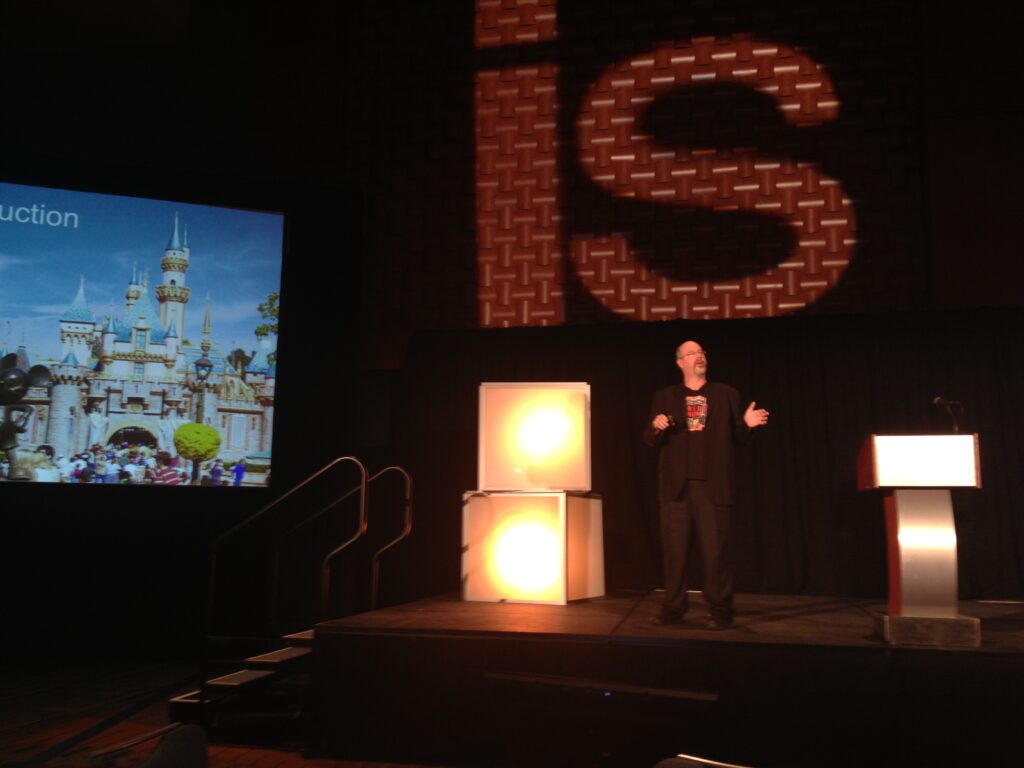What could be better than Walt Disney, responsive design and personal branding? I’m in!
The Usability & Experience session is packed. Everyone is excited to hear from Joseph Dickerson (User Experience Architect), Stephen Pierchala (Web and Mobile Performance Evangelist at Compuware), Giovanni Calabro (VP of Design at Siteworx) and Loni Stark (Director of Product and Industry Marketing at Adobe).
 First up is Joseph who tells us that Walt Disney was the first practioner of User Centric Design. Nobody goes to Disney and just hates it. Disney obsessed over creating a high quality, fully immersive experience.
First up is Joseph who tells us that Walt Disney was the first practioner of User Centric Design. Nobody goes to Disney and just hates it. Disney obsessed over creating a high quality, fully immersive experience.
Walt Disney was also a futurist and a techno-geek. Some of the first computers used for the public were by Disney. He was always focused on giving people memorable moments that they would want to repeat. You should be doing the same thing!
Always be plussing – meaning constant improvement. That doesn/t always mean “adding” sometimes it’s just as important to pare things down to it’s essence.
Looking at Walt Disney’s original map he dreamed up shows that he had figured out that people want options.
Fix things that don’t work. Disney’s opening day was an unmitigated disaster. He fixed it… fast. Failure is always a learning experience.
Take risks. Walt almost bankrupted his company twice. Once was launching Snow White, the second was the theme park. But he made it through.
Hire smart people and set standards. Walt Disney had “Mickey’s 10 Commandments” like:
- Know your audience, don’t bore them and don’t assume you know them or understand them.
- Organize the flow of people and ideas
- Communicate with visual literacy
- Avoid overload
Test, refine and test again.
Keep moving forward. Walt never rested on his laurels. He was always looking for a way to make his product better and maximize profitability.
Next up is Stephen Pierzchala talking about Taming Complexity at the Edge.
There are 4 critical challenges:
- Exceed customer expectations for application performance
- Managing increasingly complex apps
- Contain, manage and reduce costs using online applications
- Create a business culture with an application performance focus
You only control about 1/3 of your application because you are relying on third-party vendors. Some of them are Ad Serving, Analytics and even ad verification services.
The reason you need to worry about this is because every single day these services fail, and if it brings your site down with it, you take the blame, not some faceless third-party service.
What about the myriad of OS, browser, platforms, screen sizes and connection speeds? It can be a nightmare. Your customers do not use your preferred platform, they will probably use the worst case scenario. Be ready.
You have to manage your complexity from the application, location, business process and browsers and devices points of view. You can build a way to manage that complexity, but you have to do it in a way that keeps the customer at the very center of the equation.
You have to follow customer transactions end-to-end using real data and even synthetic data. Figure out what your customers do, and start measuring.
Link up business and technical performance – which is hard because those two teams speak different languages. You need to be able to translate concerns and solutions back and forth. If your site goes down on Black Friday this year, you can be sure it won’t go down on Black Friday next year.
4 things you can do today:
- Test and monitor your business from the customer perspective
- Correlate critical business and technical metrics to prevent daya myopia
- Verify customer experience.
- Ensure you are in control of your third-party data and not vice versa
Here’s Giovanni who starts off by showing slides about his company – Siteworx and how Responsve Design is the new black. There are so many different screens available today that it’s crazy to only design for desktop.
By the end of this year, mobile phones will be the #1 way people will be accessing the internet. Are you ready? Things are changing fast.
Giovanni brings up news sites which are usually low to adopt and often mirror ways that are working somewhere else. Site specific sites (mobile sites).
Responsive design gives you a single place to display your brand for every screen size that is device agnostic. It allows you to have a single codebase that serves all visitors.
Breakpoints is how you decide what size devices you’ll target. Identify what devices drive the most engagement and profit and move forward accordingly.
Responsive design lets you focus on content! Having a good idea of what content is going to be featured lets the designers and developers make better decisions.
Responsive loves to start with mobile first, second choice is then desktop down and finally the least popular is from a tablet and out.
Loni takes the stage with a Godfather quote, “it’s not personal, it’s just business.”
She wants to talk us about making experiences personal and crafting brand experiences that make people feel good.
As digitally distracted as she is, she always makes time for the things that she is passionate about.
In 2011 US online commerce rang up a record $161.5 billion which is up over 13% over last year! There are more devices capable of connecting to the internet than there are toothbrushes (remember to check that on snopes late)!
What has become scare is attention.
Why should you do the hard work of personalization? It’s hard to do, but it is worth it because in a crowded market what is going to attract customers? Price? You want to compete with Amazon and Wal-Mart on price?
Start by looking at your KPI’s. If you’re not focused on your goal, you’ll be mired in the muck forever.
So start by being real and authentic. Second, remain relevant – add value. Finally, reach is what you’re chasing.
Case study of GM and the sub-brands under the GM umbrella. For example, Chevrolet’s content is different in different countries. The Russian Chevy customer and the US Chevy guy do not have the same concerns.
Make it easy for people to use your site from their mobile device, you never know when someone will be interacting with your brand.
Think about the experience across all channels! Find out where your high-value segments are and how to connect with them.
Personalization is driven by data, content and response.
Data includes environmental, behavior, referrer, temporal and offline variables. There is no shortage of data, it’s usally just the opposite. We will create 2 zettabytes of data this year, so no shortage of content.
So how personal do you get? Be smart, don’t creep people out. Use personalization when and where appropriate.









